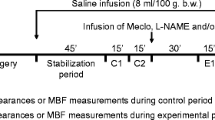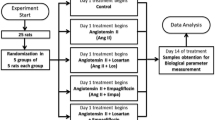Abstract
Sodium azide (NaN3, AZ) is a potent inhibitor and uncoupler of oxidative phosphorylation as well as a nitrovasodilator after being converted to nitric oxide (NO). We studied the effect of intratubular application of AZ on loop of Henle reabsorption and tubuloglomerular feedback (TGF) employing renal micropuncture experiments in nephrons with superficial glomeruli of anesthetized Munich-Wistar-Frömter rats. During perfusion of Henle’s loop downstream from an obstructing wax block, AZ (3×10–5 mol/l and 3×10–4 mol/l) concentration-dependently increased early distal tubular flow rate and sodium and potassium ion concentration (VED, [Na+]ED, [K+]ED). In comparison, application of furosemide (10–4 mol/l), the action of which is restricted to the water-impermeable thick ascending limb of Henle’s loop (TALH) and the macula densa, similarly increased [Na+]ED and [K+]ED, but did not affect VED. The effect of AZ on loop of Henle reabsorption appeared to be predominantly localized upstream to the TALH since (1) AZ significantly inhibited net fluid reabsorption (the latter being completely abolished at 3×10–4 mol/l), (2) the effect of AZ on [Na+]ED and [K+]ED could be mimicked by perfusing the Henle’s loop at a flow rate that caused a comparable increase in VED (reflecting a comparable load to TALH), and (3) the effects of AZ and furosemide were additive. In spite of the increase in [Na+]ED and [K+]ED, intratubular application of AZ caused a concentration-dependent inhibition of TGF response, the latter being assessed as the fall in early proximal tubular stop flow pressure during perfusion of Henle’s loop at increasing flow rate. Like AZ and furosemide, the NO donor sodium nitroprusside (10–4 mol/l) blunted the TGF response, but in contrast to furosemide or AZ, it caused a minor decrease in VED, without changing [Na+]ED or [K+]ED. The inhibitory effect of AZ on TGF was abolished by the NO scavenger carboxy PTIO. In summary, AZ inhibits both reabsorption in the water-permeable segment of Henle’s loop and the TGF response. The effect on reabsorption may be linked to metabolic inhibition rather than NO release, whereas the blunted TGF response appears to involve conversion to NO.
Similar content being viewed by others
Author information
Authors and Affiliations
Additional information
Received: 28 April 1998 / Accepted: 26 June 1998
Rights and permissions
About this article
Cite this article
Huang, D., Osswald, H. & Vallon, V. Intratubular application of sodium azide inhibits loop of Henle reabsorption and tubuloglomerular feedback response in anesthetized rats. Naunyn-Schmiedeberg's Arch Pharmacol 358, 367–373 (1998). https://doi.org/10.1007/PL00005266
Issue Date:
DOI: https://doi.org/10.1007/PL00005266




